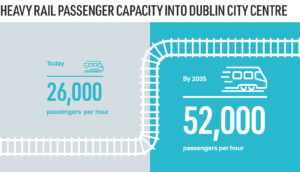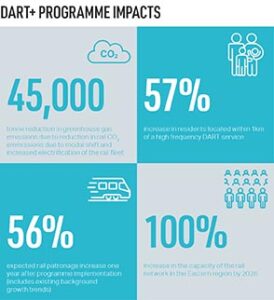Rail can take us to a more sustainable future
Vital investment to modernise Ireland’s rail network will bring huge benefits for passengers, and an electrified and efficient network will tackle urban sprawl and contribute to decarbonisation, say rail planning experts Shane Dunny and Damien Lambert.
For decades, Irish cities have sprawled. A rising population needed new homes, but a lack of infrastructure and inconsistent planning led to developers frequently building out rather than up. As distances increased between work and home, commuters took to the car.
Now, Project Ireland 2040 – the Irish Government’s overarching development framework – and other factors including recovery from coronavirus have created an opportunity to build something better and more sustainable. Within twenty years there will be an additional one million people living in the Republic of Ireland, and an additional two-thirds of a million people working in the country, so the time for co-ordinated planning for transport, commercial developments and homes is now. Modernising the rail network will facilitate compact urban development and sustainable growth while also contributing to decarbonisation goals – all key Project Ireland 2040 priorities.
This commitment is mirrored in Northern Ireland. Upon the announcement into the upcoming feasibility study into improving higher speed connectivity north-south, Infrastructure Minister Nichola Mallon was recently quoted as saying, “All-island connectivity should excite us all, not least because it better connects our communities in a more sustainable, cleaner and greener way, but also because it opens up huge potential for our economy.”
Improved outcomes for passengers

Due to decades of underinvestment, the island of Ireland’s commuter rail network is no longer fit for purpose. Services can be crowded, irregular and unreliable. Project Ireland 2040’s National Development Plan allocation of more than €2billion on rail over the next decade to overhaul the network should go some way towards resolving these problems. Central to these plans is increasing the frequency of trains. A turn-up-and-go train service will mean that instead of having to check train times, commuters can arrive on the platform, confident they will depart within minutes.
These developments will have major consequences for the areas around the train network, creating opportunities in both the residential and commercial property sectors. At present, the passenger capacity for heavy rail into Dublin City Centre is around 26,000 per hour. But with the planned upgrade through the DART+ programme – the upgrading of Dublin’s entire heavy rail system – 52,000 passengers will be able to travel per hour, hugely boosting the appeal of rail commuting.
 “There has been a strong case for investment for a long time,” says Jim Meade, Chief Executive at Irish Rail. “The pandemic has undoubtedly shifted travel patterns, however this commitment from government to upgrade services demonstrates the central role that a modernised rail network has to play in helping Ireland grow sustainably. We need high-capacity links along existing corridors between areas identified for higher-density employment and higher density residential developments – and now we are finally able to deliver.”
“There has been a strong case for investment for a long time,” says Jim Meade, Chief Executive at Irish Rail. “The pandemic has undoubtedly shifted travel patterns, however this commitment from government to upgrade services demonstrates the central role that a modernised rail network has to play in helping Ireland grow sustainably. We need high-capacity links along existing corridors between areas identified for higher-density employment and higher density residential developments – and now we are finally able to deliver.”
On the basis of the planned investment, new residential developments are scheduled to be built close to stations – in places such as Clonburris and Adamstown – these developments, combined with investment in DART+ will more than double the number of residents living within 1km of a high frequency DART service to over 600,000 people. The effects will be substantial, particularly in more deprived areas. Access to world-class transport will improve the job market, transforming opportunities for thousands of people.
“We need high-capacity links along existing corridors between areas identified for higher-density employment and higher density residential developments – and now we are finally able to deliver.” Jim Meade, Chief Executive at Irish Rail
Building around the rail network
AECOM analysis shows that this improved rail network will support compact growth and encourage better use of land, and it can become a virtuous circle: by developing the potential of the network, the areas around the stations will be boosted. Landowners and developers can work together on infill development rather than greenfield sprawl and the opportunity exists to build attractive apartment blocks and allow commuters just a brief walk to a train station rather than a long drive to work.
Co-operation between all the interested groups is not a given, but there are many examples around the world of improved rail networks significantly enhancing the commercial and residential potential of an area. In Barcelona, for example, AECOM worked on a large and complex high-speed link between Madrid and Figueras, just south of the French border.
This project focused on the La Sagrera station area, with AECOM appointed to adapt and design the railway’s infrastructure so that it integrates fully with the existing urban environment. Most of the infrastructure will be hidden under covered slabs and new landscaped parkland that will reconnect several neighbourhoods – Sagrera, Sant Marti and Sant Andreu – that were previously divided by the railway. The plan will therefore bring extensive opportunities for residential and commercial development.
Supporting growth in regional cities
In Ireland, it will be crucial to have a similar vision beyond Dublin if there is to be compact growth focused on the whole rail network. Project Ireland 2040 aims to ensure that 75 per cent of all population growth occurs outside the capital over the coming decades. The cities of Cork, Limerick, Galway and Waterford have long term integrated transport strategies in place or under development that foresee a key role for rail.
“These possibilities must be integrated in-line with planned developments so that they align with population growth,” says Jim Meade. “For example, Galway County Council wants to residentially develop the area around Oranmore station, which will in turn increase demand for rail services over time. In this way, rail can help reverse low-density settlement patterns.”
In Northern Ireland, addressing regional imbalance is also a priority. Feasibility studies have been commissioned into several suggested improvements in the North West, including the introduction of half hourly services on the Derry-Belfast line as well as new halts and associated park-and-ride facilities in Strathfoyle, Eglinton/City of Derry Airport and Ballykelly.
“In Ireland, it will be crucial to have a similar vision beyond Dublin if there is to be compact growth focused on the whole rail network. The cities of Cork, Limerick, Galway and Waterford have long term integrated transport strategies in place or under development that foresee a key role for rail.”
Cutting carbon emissions
Modernising the network will help meet environmental goals too. By shifting from diesel to electric trains, the carbon footprint of Ireland’s rail network will be substantially reduced. As commuting by train becomes a more appealing option, car travel should fall, which will cut emissions further. The pandemic has provided a huge shake-up of people’s habits, and in its aftermath, it will be important to ensure that commuters are nudged towards more environmentally-friendly travel. For examples, tools such as AECOM’s workplace mobility-as a service app My Mobility Hub can be used by organisations to implement policies and encourage and incentivise sustainable travel choices for work-related travel and beyond.
A key element of promoting sustainable growth is ensuring that the improved trains are part of a wider network of green transport. Already, AECOM has advised on improving stations in Dublin, so that they are more user-friendly, attract more passengers, and fit seamlessly into the wider transport network.
Modernising rail, as part of an integrated public transport system supported by walking and cycling facilities, will be a key part of meeting Project Ireland 2040’s goals on sustainable development, compact growth and the transition to a low-carbon society. And while recovery from coronavirus and a more active and mobile lifestyle is on everyone’s minds, we have the chance to embrace these changes to build a more resilient transport network more reflective of society’s future needs. If we can get all interested groups together and talking, we can build the network that an expanding, prosperous and more sustainable Ireland needs.







